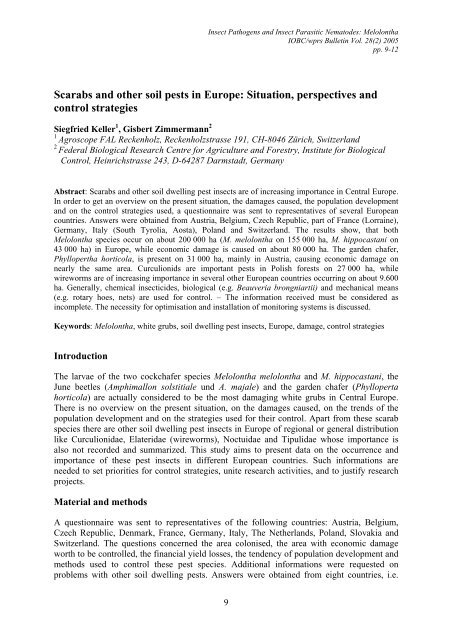IOBC/wprs Bulletin Vol. 28(2) 2005
IOBC/wprs Bulletin Vol. 28(2) 2005
IOBC/wprs Bulletin Vol. 28(2) 2005
You also want an ePaper? Increase the reach of your titles
YUMPU automatically turns print PDFs into web optimized ePapers that Google loves.
Insect Pathogens and Insect Parasitic Nematodes: Melolontha<br />
<strong>IOBC</strong>/<strong>wprs</strong> <strong>Bulletin</strong> <strong>Vol</strong>. <strong>28</strong>(2) <strong>2005</strong><br />
pp. 9-12<br />
Scarabs and other soil pests in Europe: Situation, perspectives and<br />
control strategies<br />
Siegfried Keller 1 , Gisbert Zimmermann 2<br />
1 Agroscope FAL Reckenholz, Reckenholzstrasse 191, CH-8046 Zürich, Switzerland<br />
2 Federal Biological Research Centre for Agriculture and Forestry, Institute for Biological<br />
Control, Heinrichstrasse 243, D-64<strong>28</strong>7 Darmstadt, Germany<br />
Abstract: Scarabs and other soil dwelling pest insects are of increasing importance in Central Europe.<br />
In order to get an overview on the present situation, the damages caused, the population development<br />
and on the control strategies used, a questionnaire was sent to representatives of several European<br />
countries. Answers were obtained from Austria, Belgium, Czech Republic, part of France (Lorraine),<br />
Germany, Italy (South Tyrolia, Aosta), Poland and Switzerland. The results show, that both<br />
Melolontha species occur on about 200 000 ha (M. melolontha on 155 000 ha, M. hippocastani on<br />
43 000 ha) in Europe, while economic damage is caused on about 80 000 ha. The garden chafer,<br />
Phyllopertha horticola, is present on 31 000 ha, mainly in Austria, causing economic damage on<br />
nearly the same area. Curculionids are important pests in Polish forests on 27 000 ha, while<br />
wireworms are of increasing importance in several other European countries occurring on about 9.600<br />
ha. Generally, chemical insecticides, biological (e.g. Beauveria brongniartii) and mechanical means<br />
(e.g. rotary hoes, nets) are used for control. – The information received must be considered as<br />
incomplete. The necessity for optimisation and installation of monitoring systems is discussed.<br />
Keywords: Melolontha, white grubs, soil dwelling pest insects, Europe, damage, control strategies<br />
Introduction<br />
The larvae of the two cockchafer species Melolontha melolontha and M. hippocastani, the<br />
June beetles (Amphimallon solstitiale und A. majale) and the garden chafer (Phylloperta<br />
horticola) are actually considered to be the most damaging white grubs in Central Europe.<br />
There is no overview on the present situation, on the damages caused, on the trends of the<br />
population development and on the strategies used for their control. Apart from these scarab<br />
species there are other soil dwelling pest insects in Europe of regional or general distribution<br />
like Curculionidae, Elateridae (wireworms), Noctuidae and Tipulidae whose importance is<br />
also not recorded and summarized. This study aims to present data on the occurrence and<br />
importance of these pest insects in different European countries. Such informations are<br />
needed to set priorities for control strategies, unite research activities, and to justify research<br />
projects.<br />
Material and methods<br />
A questionnaire was sent to representatives of the following countries: Austria, Belgium,<br />
Czech Republic, Denmark, France, Germany, Italy, The Netherlands, Poland, Slovakia and<br />
Switzerland. The questions concerned the area colonised, the area with economic damage<br />
worth to be controlled, the financial yield losses, the tendency of population development and<br />
methods used to control these pest species. Additional informations were requested on<br />
problems with other soil dwelling pests. Answers were obtained from eight countries, i.e.<br />
9

















